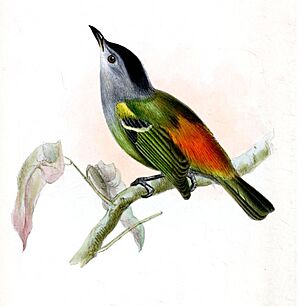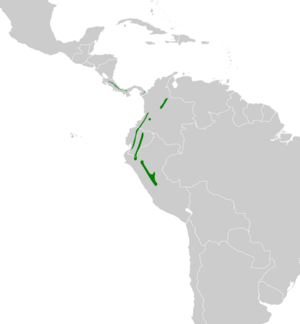Rufous-rumped antwren facts for kids
The rufous-rumped antwren (Euchrepomis callinota) is a small, colorful bird found in the forests of Central and South America. It's known for its bright orange-brown rump and its quick, high-pitched song. This bird belongs to a group called "typical antbirds," but it mostly eats small insects and spiders. You can find it in countries like Colombia, Costa Rica, Ecuador, and Peru.
Quick facts for kids Rufous-rumped antwren |
|
|---|---|
 |
|
| Conservation status | |
| Scientific classification | |
| Genus: |
Euchrepomis
|
| Species: |
callinota
|
 |
|
| Ranges of E. c. callinota and E. c. peruviana; those of E. c. venezuelana and E. c. guianensis omitted | |
| Synonyms | |
|
Terenura callinota |
|
Contents
Bird Names and History
This bird was first described by an English zoologist named Philip Sclater in 1855. He gave it the scientific name Formicivora callinota. Over time, scientists learned more about birds and how they are related. The rufous-rumped antwren was moved to a different group, or genus, called Terenura in 1885.
Later, in 2012, new studies helped scientists understand bird families even better. The rufous-rumped antwren was then placed in its current genus, Euchrepomis. This shows how scientific understanding can change as we discover more!
Different Types of Rufous-rumped Antwrens
There are four slightly different types, or subspecies, of the rufous-rumped antwren:
- E. c. callinota (Sclater, PL, 1855)
- E. c. peruviana (Meyer de Schauensee, 1945)
- E. c. venezuelana (Phelps, WH & Phelps, WH Jr, 1954)
- E. c. guianensis (Blake, 1949)
What Does It Look Like?
The rufous-rumped antwren is a small bird, about 10 to 12 centimeters (4 to 5 inches) long. It weighs about 7 to 9.5 grams (0.25 to 0.34 ounces), which is very light! It has a slender body and a long tail.
Male and Female Colors
Male and female antwrens have different colors.
- Males of the most common type (E. c. callinota) have a pale gray face with blackish areas around their eyes. Their head and neck are black, and their upper back is olive green. The lower back and rump are a bright orange-brown. Their tail is dark with olive edges. Their wings have slate gray feathers with pale yellow tips, making two bars when the wings are folded. Their throat and chest are pale gray, and their belly is pale yellow-green.
- Females have a brownish-olive head and grayish-olive sides of their face.
Both male and female antwrens have brown eyes. Their upper beak is black, and their lower beak is gray with a black tip. Their legs and feet are bluish-gray.
Subspecies Differences
The other subspecies have small differences in their colors:
- E. c. peruviana looks very similar but has a yellowish-green tint on its lower chest.
- E. c. venezuelana (known mostly from one female bird) has a darker neck and upper back. Its throat is whiter, and its belly is a lighter yellow.
- E. c. guianensis has a darker, richer olive back and brighter yellow on its wing feathers.
Where Does It Live?
The rufous-rumped antwren lives in many different places that are far apart from each other. This is called a "disjunct distribution."
Countries and Regions
The most common subspecies, E. c. callinota, lives in several separate areas:
- In Costa Rica and Panama, on the eastern side of the Cordillera de Talamanca mountains.
- In Colombia, in the Serranía del Darién and Santander areas.
- In Ecuador, on the western side of the Andes mountains, going south to El Oro Province.
- On the eastern side of the Andes, from Sucumbíos Province in Ecuador south into northern Peru.
Other subspecies live in specific regions:
- E. c. peruviana is found in central and southeastern Peru, south of the Marañón River.
- E. c. venezuelana lives in the Serranía del Perijá mountains, which are on the border of Colombia and Venezuela. It's also found in the Andes mountains in parts of Venezuela.
- E. c. guianensis lives in southern Guyana, central Suriname, and central French Guiana.
Forest Home
These birds live inside and on the edges of humid forests in foothills and mountains. They are found at different heights depending on the country:
- In Costa Rica, they live between 700 and 1,200 meters (2,300 to 3,900 feet) high.
- In Colombia, they are found between 700 and 2,500 meters (2,300 to 8,200 feet).
- In Ecuador, they live between 900 and 1,800 meters (3,000 to 5,900 feet).
- In most of Peru, they are found between 1,050 and 2,000 meters (3,400 to 6,600 feet).
How It Behaves
Movement
The rufous-rumped antwren stays in the same area all year round. It does not migrate.
Feeding Habits
This bird eats small insects and spiders, which are called arthropods. We don't know all the details of its diet yet. Rufous-rumped antwrens usually search for food in pairs. They often join groups of different bird species that are feeding together. They mostly look for food high up in the forest canopy, picking prey off leaves and branches.
Reproduction
In Costa Rica, the rufous-rumped antwren's breeding season seems to be from February to May. Scientists don't know much else about how these birds raise their young.
Vocalization
The song of the rufous-rumped antwren is described as a fast, high-pitched sound. It starts with "tsii-tsii-tsi" and then speeds up into a quick trill, like "titititititititi." Another way to describe it is "tew tew-tew-ti-ti-ti't't't't't't'ti," which also speeds up and ends in a trill. Its calls are high "tsi" and "ti" notes.
Status and Conservation
The IUCN (International Union for Conservation of Nature) has listed the rufous-rumped antwren as a species of "Least Concern." This means it's not currently in danger of disappearing. It lives in a very large area, and there are at least 50,000 adult birds. However, scientists believe the number of these birds is slowly going down.
No major threats have been found for this bird. It is considered rare in Costa Rica and not very common in Colombia, Ecuador, and Peru. Even though there isn't much data, the rufous-rumped antwren could be affected by people clearing forests for farming. Losing its forest home is the biggest risk to this bird.


